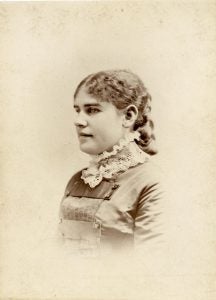
Katharine Coman was born in Newark, Ohio, on November 23, 1857, to Levi Parsons Coman and Martha Seymour. She graduated from the University of Michigan in 1880 and subsequently became a professor of English at Wellesley College. Within a year, she had switched over to teaching history. By 1885, she had found her passion as a professor of history specializing in economics. During her teaching years, she published multiple influential books, including Industrial History of the United States in what were then the new fields of labor and industrial history. She was among the first historians to use government documents like statistical reports and local newspapers as primary sources in her histories. Her pioneering scholarship was so influential as to result in the name of a chair established in her honor in 1921: the Katharine Coman Professorship of Industrial History. Later in her career, Coman earned a Carnegie grant to work on a series of volumes dealing with the United States’ early economic development. She passionately worked on this project throughout her final years of life.[1]
In 1900, Katharine Coman became Dean of Wellesley College, until her failing health due to breast cancer necessitated her withdrawal in 1913. Her illness was extreme far before this point, however—it was said that “her most important book, The Economic Beginnings of the Far West, was joyfully and persistently wrought out, through travel, study and writing, during years which by many women would have been given over to wretched invalidism.”[2] Though she underwent multiple operations (a double mastectomy was almost certainly among them) her cancer metastasized. She died when only 58 years old, on January 11, 1915.
A good amount of what is known about Katherine Coman is due to the efforts of Katherine Lee Bates, a fellow professor at Wellesley College and a prolific poet, who wrote the lyrics to “America the Beautiful.” The pair began living together in what was called a “Boston marriage” beginning in 1890. Eventually, they built a house together, dubbing it “The Scarab” in honor of a shared trip they had taken to Europe. It’s impossible to state definitively whether the two were lovers, as Bates’ language about their feelings was both intense and amorphous. However, they did share a deep and, at the time, socially acceptable romantic friendship, which later prompted Bates to document Coman’s life. She wrote exhaustively of the progress of Coman’s cancer, and penned a short biography of Coman in a poetry book Yellow Clover, which she then dedicated to her friend.[3]
According to Bates, Coman was politically engaged, courageous in adversity, and possessed a “vigorous and adventurous personality.”[4] When suffering under early forms of cancer treatment, Coman was, in Bates’ diaries, “helpless but so brave and patient.” She frequently travelled (as did Bates) to Europe, the western United States, Scandinavia, and Egypt, working all the while on researching economic history. Along with Bates, Coman worked tirelessly in establishing one of the first settlement house on the East Coast—an institution founded in 1892, which would provide education, recreation, and other services to the local community.[5]
Both Katharine Coman’s pioneering influence in the field of economic history and her service to the people of Boston had impacts reaching far beyond her death. Today her achievements are honored through the Katherine Ellis Coman House in the University of Michigan.
Notes:
- Katharine Lee Bates, Yellow clover: a book of remembrance (New York: E.P. Dutton & Company, 1922).
- Bates, “For Katharine Coman’s Family and Innermost Circle of Friends. Not for Print nor in any way for General Circulation.” Legacy 23, no. 1 (2006): 74-85.
- Judith Schwarz, “‘Yellow Clover’: Katharine Lee Bates and Katharine Coman.” Frontiers: A Journal of Women Studies 4, no. 1 (1979): 59-67.
- Bates, Yellow Clover.
- Ellen Leopold, “‘My soul is Among Lions’: Katharine Lee Bates’s Account of the Illness and Death of Katharine Coman,” Legacy 23, no. 1 (2006): 60-73.
Image Credit:
“Studio portrait of Katherine Coman,” University of Michigan Student Portraits.



